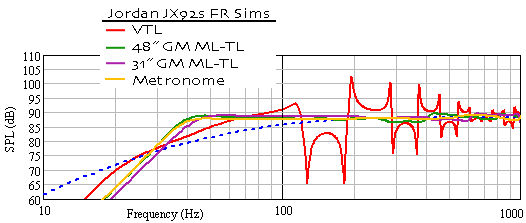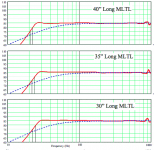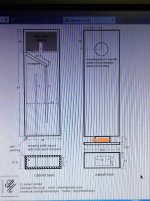The low pass filter that I'm suggesting for the rear driver in a bipole speaker arrangement is intended to cope with the propagation around the enclosure from rear to front. My experience was that this propagation causes the forward radiation to drop some 3-4 dB between 400-500 hz for my speakers. It isn't a BSC technique per se as you don't need BSC for a bipolar speaker but rather how to prevent the forward response drop from the bipolar arrangement.
I mentioned 'above the BSC region' merely to maintain the inherent bipole nature of the speaker while low passing the rear driver to mitigate the interference between the two drivers above a wavelength distance around the box. This path length is determined by the dimensions around the box so it would vary according to each specific speaker design.
I mentioned 'above the BSC region' merely to maintain the inherent bipole nature of the speaker while low passing the rear driver to mitigate the interference between the two drivers above a wavelength distance around the box. This path length is determined by the dimensions around the box so it would vary according to each specific speaker design.
Last edited:
Clarification
Hi all,
This is my first post here and also my first attempt into diy speakers so please be gentle if my questions make little or no sense to you.
I want to make a speaker set based on Jordan Eikona 2 driver and I think I read all info available on the internet, but I'm yet to decide between the VTL design and Jim Griffin's 40" MLTL design. I read some opinions that the VTL design is not quite well fine tuned for the Eikona 2 therefore any input on this would be greatly appreciated, especially from someone who listened to both.
Now regarding Jim Griffin's 40" design, while I found the 30" design on Jordan's website, I'm looking for several clarification:
A) other than heigh of the speaker and the driver location (8" down from speaker top) all the other dimensions remain the same?
B) the port is on a side of the speaker, not on the front? Does this matter?
That would be all for now.
Thanks in advance
This afternoon I modeled three variations on a MLTL for the Jordan Eikona 2 driver with Martin King’s MLTL simulation spread sheet. The procedure with the MJK spread sheets is that you are the optimizer. Thus you vary the physical configuration (length, driver location, port location, port diameter and length, cross-section area of the line, and stuffing density) to yield a desired goal. My objective was to attain a flat system frequency response. Some inherent knowledge of MLTL variables and the simulation assist the user as they navigate through the effort.
For this example the three cases are all straight transmission lines and have inside tube lengths of 40”, 35”, and 30”. Most MLTLs are floor standing speakers so you wish to have the driver located so that sitting listeners are near ear height in the room. For each case in this study the driver is spaced at 1/5th times the length of the line down from the inside top. Thus the spacing is 8”, 7”, and 6” for this study. The port is centered two inches above bottom of the tube in all cases. I iterated and established the internal cross-sectional area (product of the width and depth) of the MLTL cases at 56 square inches. To smooth the response of the MLTL I used a stuffing density of 0.75 pounds per cubic foot for the filling material. Iteration of the port diameter and length established 2” diameter by 6” long as sufficient.
The specified stuffing fills the volume from the top of the enclosure to 3 inches below the driver. Meniscus Audio offers flat sheets of a bonded Dacron which is 0.75 pounds per cubic foot so this would take the guess work out of stuffing the enclosure.
I have attached a file that shows the system frequency response of my simulation efforts. Notice that the responses are all excellent and extend below 30 Hz before their 3 dB down low end response. The 40” line extends to below 24 Hz, the 35” line extends to below 26 Hz, and the 30” line goes to about 28 Hz. Any of these examples would provide exceptional performance. The Eikona is an impressive driver!
Now I always state the MLTL (and any ported box for that matter) will perform well for most musical situations but their performance is limited by the linear Xmax of the driver. These aren’t subwoofers and shouldn’t be expected to be used as such.
Finally, as with all of the Martin King simulation results, they are not for commercial usage without licensing from him.
View attachment 465337
Hi all,
This is my first post here and also my first attempt into diy speakers so please be gentle if my questions make little or no sense to you.
I want to make a speaker set based on Jordan Eikona 2 driver and I think I read all info available on the internet, but I'm yet to decide between the VTL design and Jim Griffin's 40" MLTL design. I read some opinions that the VTL design is not quite well fine tuned for the Eikona 2 therefore any input on this would be greatly appreciated, especially from someone who listened to both.
Now regarding Jim Griffin's 40" design, while I found the 30" design on Jordan's website, I'm looking for several clarification:
A) other than heigh of the speaker and the driver location (8" down from speaker top) all the other dimensions remain the same?
B) the port is on a side of the speaker, not on the front? Does this matter?
That would be all for now.
Thanks in advance
I would expect Jim’s design to give better performance. From our sims of the VTL it is a guessed design using Classic theory whereas Jim’s is properly modeled.
dave
dave
All these resonant designs to squeeze some LF extension out of a too small driver for the job 🙄 why bother? Do it right and add a woofer or two 🙂
For simplicity. For instance, at this summer’s diyFEST, the single driver Alpari 10PeN in Frugel-Horn XL was considered to edge out the WAW Tyson V2.
BTW, Eikona 2 should work well in Frugel-horn XL.
dave
BTW, Eikona 2 should work well in Frugel-horn XL.
dave
I'd be interested to see your sims of the VTL if you can post them, since this is what I have , well sort of 😉
Well mass loaded is a little different is it not? Sort of a hybrid ported BR and more of a resonant design. Whats the metronome?
It is a true TL, but the restricted terminus aids in the terminus’ LP function so one does not have to use as much stuffing. It also means that one can get away with a shorter line.
MJK & Augspurger opened up a large amount of "TL space” to exploration.
dave
MJK & Augspurger opened up a large amount of "TL space” to exploration.
dave
Simiaone asked about my Eikona 2 models summarized in Post #8 and repeated in Post #82 above in this thread. His questions and answers are below)
A) Other than height of the speaker and the driver location (8" down from speaker top for the 40" example) all the other dimensions remain the same?
Yes
B) the port is on a side of the speaker, not on the front? Does this matter?
Should not matter. I prefer rear port exits but if you wish you could use front or side if you wish.
Notice that the low end (F3 down points) for the frequency responses in Post #8 are all close. Hence, the performance is excellent for any of these three designs.
Jim
A) Other than height of the speaker and the driver location (8" down from speaker top for the 40" example) all the other dimensions remain the same?
Yes
B) the port is on a side of the speaker, not on the front? Does this matter?
Should not matter. I prefer rear port exits but if you wish you could use front or side if you wish.
Notice that the low end (F3 down points) for the frequency responses in Post #8 are all close. Hence, the performance is excellent for any of these three designs.
Jim
the low end (F3 down points)
As per Toole, F3 is a meaningless determinant of LF response, one is much better to look at F6/F10. I have taken the liberty of editing Jim’s simulated FR graphs to give people a better idea of the responses. Dofferences are small, they all fall into the low 20s (an exceptional result), with the 30” probably having the best looking knee at roll-off. The knee of the 40” could likely be tamed by substituting a high ratio slot terminus.
dave
Attachments
The Jordan VTL is a guessed design, it does not perform all that well (at least it does not model well)… one of Jim’s ML-TLs would be better. You can change the aspect ratio if you want it wider and shallower.
Sims w JX92, but the Eikona will not affect the box related artifacts.

dave
Sims w JX92, but the Eikona will not affect the box related artifacts.
dave
Dave. Thanks for feedback.
I will go through this thread to locate the plans of Jim ML TL drawing.
I will go through this thread to locate the plans of Jim ML TL drawing.
I want to build the cabinet for eikona 2. See picture.
My question : Can i raised the area marked by red from 5 to 15 cm so that it is at my ear level.?
Hi - Yes, you can raise the height of the foot. The distance of the port to the floor is not critical.
If you want to see the MLTL designs, there are some on our website
loudspeaker plans - E J Jordan Designs
The VTL is not a "guessed design", although not the product of computer modelling. Ted had considerable experience designing acoustic labyrinth and TLs going back to his first published article in 1951 (a concrete labyrinth enclosure).
The decoupled chamber TL design has been around a long time and he sketched out the idea in his early articles for Wireless World, some time before Robert Fris popularised it as the Daline in Hi-Fi News. The VTL itself went through a number of iterations during its development for the commercial version, the Konus Essence. It works very well, although that said I have not compared it to any of the MLTLs on a side-by-side basis.
The VTL is not a "guessed design", although not the product of computer modelling. Ted had considerable experience designing acoustic labyrinth and TLs going back to his first published article in 1951 (a concrete labyrinth enclosure).
Guessed is the term i use for any design using classic methodology. Proper models have brought much better TLs.
dave
- Status
- Not open for further replies.
- Home
- Loudspeakers
- Full Range
- Jordan Eikona 2 Designs

